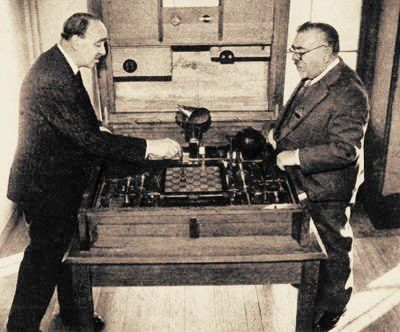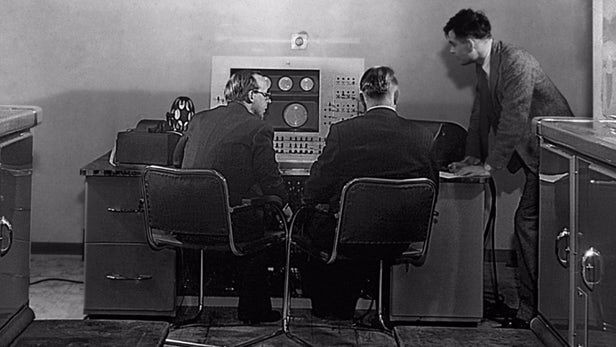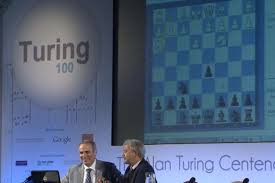In the fascinating history of computer chess, the journey from conceptualization to sophisticated game-playing engines is marked by visionary pioneers. Stepping beyond the automata of the Enlightenment, the early 20th century witnessed the dawn of genuine chess computers, crafted by scientific minds who sought to build their own ‘Mechanical Turks’. Among these innovators, Leonardo Torres y Quevado and Alan Turing stand out as pivotal figures.
Leonardo Torres y Quevado, a Spanish civil engineer and mathematician, embarked on this pioneering path as early as 1912. He began constructing ‘El Ajedrecista’ (The Chessplayer), a remarkable mechanical prototype designed to automatically play a King and Rook endgame against a lone King from any given position. By 1914, El Ajedrecista was unveiled to the public at the University of Paris, creating a sensation. Initially, mechanical arms physically moved the chess pieces. By 1920, Torres y Quevado enhanced his creation, incorporating electromagnets beneath the board. This upgrade gave the device an almost spectral quality, as if pieces moved by unseen hands, adding to the mystique of the game.
‘El Ajedrecista’ was not merely a demonstration piece; it was one of the first autonomous machines capable of playing chess in a constrained scenario. It could consistently achieve checkmate using a straightforward algorithm. While it might not always find the most efficient path to checkmate, nor did it strictly adhere to the 50-move rule, it was unfailingly successful in delivering mate whenever white (assigned to the machine with King and Rook) faced black’s King, regardless of the initial setup. The machine was also designed with error detection. Any illegal moves or positions attempted by a human opponent were immediately flagged with a light signal. Victory for the machine was declared with a flourish: a sound effect accompanied by a recorded voice announcing “jaque mate!”.
 Close-up view of the mechanical components of El Ajedrecista, highlighting its intricate design and engineering.
Close-up view of the mechanical components of El Ajedrecista, highlighting its intricate design and engineering.
Moving forward in time, the concept of computer chess took a more abstract yet equally pioneering turn with Alan Turing’s ‘Turochamp’. Named after the celebrated British mathematician and computer scientist Alan Turing (1912-1954), Turochamp, short for Turing-Champernowne, holds a unique place in history as arguably the first historical computer chess program. Turing, renowned for his foundational contributions to theoretical computer science and his crucial role in breaking the Enigma code during World War II, laid the groundwork for modern computing.
Developed in 1948 in collaboration with his colleague Professor David Gawen Champernowne at King’s College, Cambridge, Turochamp emerged from a blend of their surnames. In the summer of 1952, a recorded match pitted the Turochamp program, operated manually, against British computer specialist Alick Glennie. In this landmark, albeit manually executed game, Turochamp was defeated in 29 moves.
 Alan Turing, a pioneer of computer science and artificial intelligence, whose work laid the foundation for computer chess programs like Turochamp.
Alan Turing, a pioneer of computer science and artificial intelligence, whose work laid the foundation for computer chess programs like Turochamp.
Remarkably, Turochamp operated without a traditional computer. The program was executed through pencil-and-paper calculations. Each move was painstakingly computed by hand, with turns taking approximately thirty minutes to complete. The methodology involved calculating potential moves and opponent responses, assigning point values to resulting game states, and selecting the move with the highest average point value. This process allowed Turochamp to play a full game against a human, albeit at a novice level due to the limitations of manual computation and the program’s simplicity.
 Diagram illustrating the pencil-and-paper method used to operate the Turochamp chess program, showcasing the manual calculation of moves.
Diagram illustrating the pencil-and-paper method used to operate the Turochamp chess program, showcasing the manual calculation of moves.
Champernowne recounted the development process, noting, “Most of our attention went to deciding which moves were to be followed up. …Captures had to be followed up at least to the point where no further captures was immediately possible. Check and forcing moves had to be followed further. We were particularly keen on the idea that whereas certain moves would be scorned as pointless and pursued no further others would be followed quite a long way down certain paths. In the actual experiment I suspect we were a bit slapdash about all this and must have made a number of slips since the arithmetic was extremely tedious with pencil and paper. Our general conclusion was that a computer should be fairly easy to programme to play a game of chess against a beginner and stand a fair chance of winning or least reaching a winning position.” (Copeland, 2004). This insight reveals the rudimentary yet insightful approach to move selection and game strategy employed in Turochamp.
 Wilhelmina Champernowne, the first opponent to play a test game against Turochamp, highlighting the early human-computer chess interaction.
Wilhelmina Champernowne, the first opponent to play a test game against Turochamp, highlighting the early human-computer chess interaction.
Although the original Turochamp algorithm was lost, Ken Thompson and Mathias Feist reconstructed it in 2000. Turing had initiated the process of implementing Turochamp on a computer, the Ferranti Mark 1, in 1950, but his untimely death in 1954 left the work unfinished. The 2000 reconstruction stayed true to the original concept, with the program still operating by looking just two moves ahead – a stark contrast to the powerful chess engines of that era, like IBM’s Deep Blue. The reconstructed engine was released to the public and is available through ChessBase, offering a historically significant, if not formidable, sparring partner within modern chess programs like Fritz or Rybka.
In a remarkable event, Turochamp (Reconstructed) faced one of chess history’s giants, Garry Kasparov.
 Garry Kasparov playing against the reconstructed Turochamp program at the Alan Turing Centenary Conference in 2012.
Garry Kasparov playing against the reconstructed Turochamp program at the Alan Turing Centenary Conference in 2012.
At the 2012 Alan Turing Centenary Conference in Manchester, UK, Kasparov played a public match against this 60-year-old chess program. Kasparov defeated the digital Turochamp in a swift 16 moves. Despite the swift victory, Kasparov expressed admiration for the machine and its creator, stating, “It was an outstanding accomplishment… Alan Turing is one of the very few people about who you could say that if he had lived longer the world would be a different place.”
 Garry Kasparov reflecting on Alan Turing's legacy and the significance of Turochamp in the history of computer chess.
Garry Kasparov reflecting on Alan Turing's legacy and the significance of Turochamp in the history of computer chess.
The endeavors of Torres y Quevado and Turing, though separated by time and approach, represent critical milestones in the narrative of computer chess. Torres y Quevado’s ‘El Ajedrecista’ demonstrated the feasibility of mechanical chess automatons, while Turing’s ‘Turochamp’ pioneered algorithmic chess programming. Together, they embody the spirit of early pioneers in computer chess, setting the stage for the sophisticated chess engines and AI of today.

